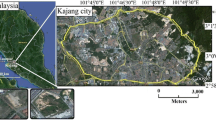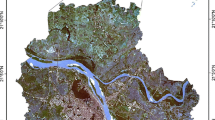Abstract
In recent decades, attaining urban sustainability is the primary goal for urban planners and decision makers. Among various aspects of urban sustainability, environmental protection such as agricultural and forest conservations is very important in tropical countries like Malaysia. In this regard, compact urban development due to high density, rural development containment is known as the most sustainable urban forms. This paper attempts to propose an integrated modeling approach to predict the future land use changes by considering city compactness paradigms. First, the cellular automata (CA) were applied for calculating land use conversion. Next, weights-of-evidence (WoE) which is based on Bayes theory was utilized to calibrate CA model and to support the transitional rule assessment. Several urban-related parameters as well as compact city indicators were utilized to estimate the future land use maps. The results showed how compact development parameters and site characteristics can be combined using the WoE model to predict the probability of land use changes. The modeling approach supports the essential logic of probabilistic methods and indicates that spatial autocorrelation of various land use types and accessibility is the main drivers of urban land use changes.







Similar content being viewed by others
References
Abdullahi S, Pradhan B (2016) Sustainable brownfields land use change modeling using GIS-based weights-of-evidence approach. Appl Spat Anal Policy 9:21–38
Abdullahi S, Mahmud AR, Pradhan B (2014) Spatial modelling of site suitability assessment for hospitals using geographical information system-based multicriteria approach at Qazvin city, Iran. Geocarto Int 29:164–184
Abdullahi S, Pradhan B, Jebur MN (2015a) GIS-based sustainable city compactness assessment using integration of MCDM, Bayes theorem and RADAR technology. Geocarto Int 30:365–387
Abdullahi S, Pradhan B, Mansor S, Shariff ARM (2015b) GIS-based modeling for the spatial measurement and evaluation of mixed land use development for a compact city. GISci Remote Sens 52:18–39
Al-shalabi M, Billa L, Pradhan B, Mansor S, Al-Sharif AA (2013) Modelling urban growth evolution and land-use changes using GIS based cellular automata and SLEUTH models: the case of Sana’a metropolitan city, Yemen. Environ Earth Sci 70:425–437
Al-sharif AA, Pradhan B (2013) Monitoring and predicting land use change in Tripoli Metropolitan City using an integrated Markov chain and cellular automata models in GIS. Arab J Geosci 7:1–11
Althuwaynee OF, Pradhan B, Lee S (2012) Application of an evidential belief function model in landslide susceptibility mapping. Comput Geosci 44:120–135
Araya YH, Cabral P (2010) Analysis and modeling of urban land cover change in Setubal and Sesimbra, Portugal. Remote Sens 2:1549–1563
Arsanjani JJ, Helbich M, Kainz W, Boloorani AD (2013) Integration of logistic regression, Markov chain and cellular automata models to simulate urban expansion. Int J Appl Earth Obs Geoinf 21:265–275
Bagdanavičiūtė I, Valiūnas J (2013) GIS-based land suitability analysis integrating multi-criteria evaluation for the allocation of potential pollution sources. Environ Earth Sci 68:1797–1812
Batty M, Xie Y (1994) From cells to cities. Environ Plan B 21:531–548
Batty M, Xie Y, Sun Z (1999) Modeling urban dynamics through GIS-based cellular automata. Comput Environ Urban Syst 23:205–233
Bingham G et al (1995) Issues in ecosystem valuation: improving information for decision making. Ecol Econ 14:73–90
Bonham-Carter G (1994) Geographic information systems for geoscientists: modelling with GIS, vol 13. Elsevier, Ottawa
Burton E (2002) Measuring urban compactness in UK towns and cities. Environ Plan B 29:219–250
Burton E, Jenks M, Williams K (2003) The compact city: a sustainable urban form?. Routledge, Abingdon
Chen C, He B, Zeng Z (2013) A method for mineral prospectivity mapping integrating C4. 5 decision tree, weights-of-evidence and m-branch smoothing techniques: a case study in the eastern Kunlun Mountains, China. Earth Sci Inform 7:13–24
Coppedge BR, Engle DM, Fuhlendorf SD (2007) Markov models of land cover dynamics in a southern Great Plains grassland region. Landsc Ecol 22:1383–1393
Corner RJ, Dewan AM, Chakma S (2014) Monitoring and prediction of land-use and land-cover (LULC) change. In: Dhaka Megacity. Springer, pp 75–97
Dadhich PN, Hanaoka S (2011) Spatio-temporal urban growth modeling of Jaipur, India. J Urban Technol 18:45–65
Dahal RK, Hasegawa S, Nonomura A, Yamanaka M, Masuda T, Nishino K (2008) GIS-based weights-of-evidence modelling of rainfall-induced landslides in small catchments for landslide susceptibility mapping. Enviro Geol 54:311–324
De Chiara J (2001) Time-saver standards for building types. McGraw-Hill Professional Publishing, New York
Dempster AP (1967) Upper and lower probabilities induced by a multivalued mapping. Ann Math Stat 38:325–339
Ding C (2004) Urban spatial development in the land policy reform era: evidence from Beijing. Urban Stud 41:1889–1907
Gainza X, Livert F (2013) Urban form and the environmental impact of commuting in a segregated city, Santiago de Chile. Environ Plan B 40:507–522
Gettings ME, Bultman MW, Fisher FS (2004) A complex systems model approach to quantified mineral resource appraisal. Environ Manag 33:87–98
Grimm V et al (2006) A standard protocol for describing individual-based and agent-based models. Ecol Model 198:115–126
Gu Z, Sun Q, Wennersten R (2013) Impact of urban residences on energy consumption and carbon emissions: an investigation in Nanjing, China. Sustain Cities Soc 7:52–61
Hagoort M, Geertman S, Ottens H (2008) Spatial externalities, neighbourhood rules and CA land-use modelling. Ann Reg Sci 42:39–56
Hamedianfar A, Shafri HZM (2015) Detailed intra-urban mapping through transferable OBIA rule sets using WorldView-2 very-high-resolution satellite images. Int J Remote Sens 36:3380–3396
Hathout S (2002) The use of GIS for monitoring and predicting urban growth in East and West St Paul, Winnipeg, Manitoba, Canada. J Environ Manag 66:229–238
He B, Chen C, Liu Y (2010) Mineral potential mapping for Cu-Pb-Zn deposits in the East Kunlun Region, Qinghai Province, China, integrating multi-source geology spatial data sets and extended weights-of-evidence modeling. GISci Remote Sens 47:514–540
Heistermann M, Müller C, Ronneberger K (2006) Land in sight?: Achievements, deficits and potentials of continental to global scale land-use modeling. Agric Ecosyst Environ 114:141–158
Houghton R (1994) The worldwide extent of land-use change. Bioscience 44:305–313
Kamusoko C, Aniya M, Adi B, Manjoro M (2009) Rural sustainability under threat in Zimbabwe–simulation of future land use/cover changes in the Bindura district based on the Markov-cellular automata model. Appl Geogr 29:435–447
Kocabas V, Dragicevic S (2007) Enhancing a GIS cellular automata model of land use change: Bayesian networks, influence diagrams and causality. Trans GIS 11:681–702
Koomen E, Borsboom-van Beurden J (2011) Land-use modelling in planning practice, vol 101. Springer, Berlin
Koomen E, Stillwell J (2007) Modelling land-use change. Theories and methods. In: Stillwell J, Koomen E, Bakema A, Scholten HJ (eds) Modelling land-use change: progress and applications. Springer, Berlin, pp 1–24
Kuijpers-Linde MAJ, Bouwman A, M-e Natuurplanbureau (2007) Nederland later: tweede duurzaamheidsverkenning: deel fysieke leefomgeving Nederland. Milieu en Natuur Planbureau, Bilthoven
Li X, Yeh AG-O (2002) Neural-network-based cellular automata for simulating multiple land use changes using GIS. Int J Geogr Inf Sci 16:323–343
Li X, Yang Q, Liu X (2008) Discovering and evaluating urban signatures for simulating compact development using cellular automata. Landsc Urban Plan 86:177–186
Livingstone K, Rogers R (2003) Housing for a compact city. Greater London Authority, London
Maria de Almeida C, Batty M, Vieira Monteiro AM, Câmara G, Soares-Filho BS, Cerqueira GC, Pennachin CL (2003) Stochastic cellular automata modeling of urban land use dynamics: empirical development and estimation. Comput Environ Urban Syst 27:481–509
Matthews RB, Gilbert NG, Roach A, Polhill JG, Gotts NM (2007) Agent-based land-use models: a review of applications. Landsc Ecol 22:1447–1459
Medley KE, Okey BW, Barrett GW, Lucas MF, Renwick WH (1995) Landscape change with agricultural intensification in a rural watershed, southwestern Ohio, USA. Landsc Ecol 10:161–176
Mubareka S, Koomen E, Estreguil C, Lavalle C (2011) Development of a composite index of urban compactness for land use modelling applications. Landsc Urban Plan 103:303–317
Norte Pinto N, Pais Antunes A (2007) Cellular automata and urban studies: a literature survey Archit City. Environ 1:367–398
Parker DC, Manson SM, Janssen MA, Hoffmann MJ, Deadman P (2003) Multi-agent systems for the simulation of land-use and land-cover change: a review. Ann Assoc Am Geogr 93:314–337
Pijanowski BC, Brown DG, Shellito BA, Manik GA (2002) Using neural networks and GIS to forecast land use changes: a land transformation model. Comput Environ Urban Syst 26:553–575
Pontius RG Jr, Millones M (2011) Death to Kappa: birth of quantity disagreement and allocation disagreement for accuracy assessment. Int J Remote Sens 32:4407–4429
Pontius RG Jr, Schneider LC (2001) Land-cover change model validation by an ROC method for the Ipswich watershed, Massachusetts, USA. Agric Ecosyst Environ 85:239–248
Pradhan B, Lee S (2010) Delineation of landslide hazard areas on Penang Island, Malaysia, by using frequency ratio, logistic regression, and artificial neural network models. Environ Earth Sci 60:1037–1054
Pradhan B, Oh H-J, Buchroithner M (2010) Weights-of-evidence model applied to landslide susceptibility mapping in a tropical hilly area. Geomat Nat Hazard Risk 1:199–223
Regmi NR, Giardino JR, Vitek JD (2010) Modeling susceptibility to landslides using the weight of evidence approach: Western Colorado, USA. Geomorphology 115:172–187
Sang L, Zhang C, Yang J, Zhu D, Yun W (2011) Simulation of land use spatial pattern of towns and villages based on CA–Markov model. Math Comput Model 54:938–943
Shafer G (1976) A mathematical theory of evidence, vol 1. Princeton University Press, Princeton
Skapura DM (1996) Building neural networks. Addison-Wesley Professional, New York
Song Y, Merlin L, Rodriguez D (2013) Comparing measures of urban land use mix. Comput Environ Urban 42:1–13
Tan KC, San Lim H, MatJafri MZ, Abdullah K (2010) Landsat data to evaluate urban expansion and determine land use/land cover changes in Penang Island, Malaysia. Environ Earth Sci 60:1509–1521
Tayyebi A, Pijanowski BC (2014) Modeling multiple land use changes using ANN, CART and MARS: comparing tradeoffs in goodness of fit and explanatory power of data mining tools. Int J Appl Earth Obs Geoinf 28:102–116
Tayyebi A, Pijanowski BC, Linderman M, Gratton C (2014) Comparing three global parametric and local non-parametric models to simulate land use change in diverse areas of the world. Environ Model Softw 59:202–221
Thiam AK (2005) An evidential reasoning approach to land degradation evaluation: Dempster-Shafer theory of evidence. Trans GIS 9:507–520
Tien Bui D, Pradhan B, Lofman O, Revhaug I, Dick OB (2012) Spatial prediction of landslide hazards in Hoa Binh province (Vietnam): a comparative assessment of the efficacy of evidential belief functions and fuzzy logic models. Catena 96:28–40
Verburg PH, van Eck JR, de Nijs TC, Dijst MJ, Schot P (2004) Determinants of land-use change patterns in the Netherlands. Environ Plan B 31:125–150
Wang F, Hasbani J-G, Wang X, Marceau DJ (2011) Identifying dominant factors for the calibration of a land-use cellular automata model using Rough Set Theory. Comput Environ Urban Syst 35:116–125
White R, Engelen G (1993) Cellular automata and fractal urban form: a cellular modelling approach to the evolution of urban land-use patterns. Environ Plan A 25:1175–1199
Wu F (1998) SimLand: a prototype to simulate land conversion through the integrated GIS and CA with AHP-derived transition rules. Int J Geogr Inf Sci 12:63–82
Youssef AM, Pradhan B, Pourghasemi HR, Abdullahi S (2015) Landslide susceptibility assessment at Wadi Jawrah Basin, Jizan region, Saudi Arabia using two bivariate models in GIS. Geosci J 19:449–469
Acknowledgements
The authors would like to thank the local planning council (JPBD), Malaysia, for providing various data sets used in this paper. In addition, we wish to thank the Ministry of Higher Education of Malaysia for financial support for this research. Thanks to two anonymous reviewers for their valuable comments which helped us to improve the earlier version of the manuscript.
Author information
Authors and Affiliations
Corresponding author
Rights and permissions
About this article
Cite this article
Abdullahi, S., Pradhan, B. Land use change modeling and the effect of compact city paradigms: integration of GIS-based cellular automata and weights-of-evidence techniques. Environ Earth Sci 77, 251 (2018). https://doi.org/10.1007/s12665-018-7429-z
Received:
Accepted:
Published:
DOI: https://doi.org/10.1007/s12665-018-7429-z




